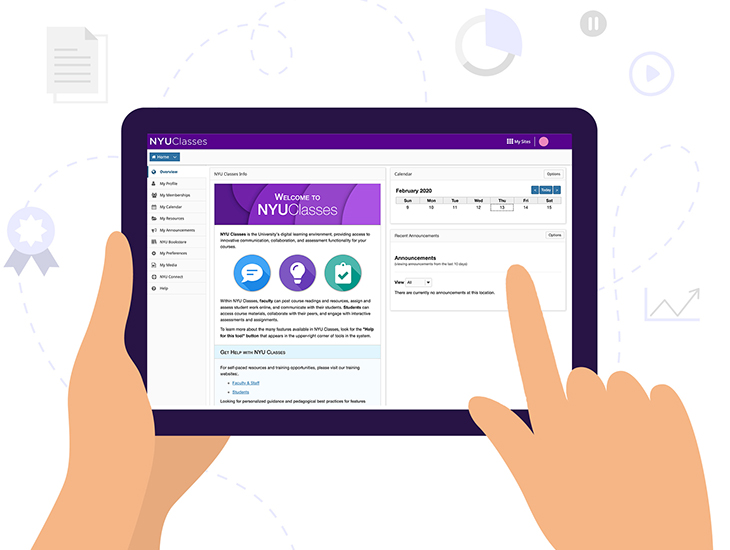In a major effort to keep students on track and making progress toward their degrees during the COVID-19 epidemic, NYU Shanghai will be launching February 17 a digital teaching and learning program that is unprecedented both in size and scope for the university.
With the campus closed until at least the end of February to prevent the spread of the coronavirus, university officials have decided to deliver 293 courses slated for Spring 2020 using state-of-the-art digital tools. About 820 undergraduate students and 130 graduate students will be signing on for distance learning from as far away as Africa, the Caribbean, the United States, and Shanghai’s Xuhui district. Another 620 NYU Shanghai undergraduate students will be studying away in New York and at sites throughout the NYU Global Network.
“An extraordinarily high level of collaboration and coordination has taken place internally among all segments of the university,” said Provost Joanna Waley-Cohen. “Faculty and staff in both New York and Shanghai, the latter under the most trying conditions, have been working tirelessly to make sure that students’ needs can be met wherever they are.”
In particular, the NYU Shanghai’s Research and Instructional Technology Services (RITS) and Information Technology Service Center (IT) teams have been working throughout the Lunar New Year with their counterparts in New York to ensure that remote teaching can go on smoothly.
Comprehensive tools to teach in both synchronous and asynchronous ways
A wide variety of useful online tools will be available to professors to engage students and encourage live feedback and interaction, including NYU Classes, NYU Stream, NYU Zoom, and VoiceThread.
Remote teaching is not new to many NYU students and faculty. For example, Ratan Dey, Assistant Professor of Practice in Computer Science at NYU Shanghai, gave online courses a few years ago at the NYU Tandon School of Engineering. For that course, he used many tools including Gradebook, Zoom, and ProctorU. Dey has been sharing his experiences about those tools via WeChat group with his colleagues in NYU Shanghai’s Engineering and Computer Science division. Keith Ross, Dean of Engineering and Computer Science at NYU Shanghai, also has extensive experience teaching online, having founded a startup that developed online asynchronous voice message boards for education and language learning.
All NYU Shanghai professors can use the NYU Classes platform to publish course information, share resources, assign and grade homework, and more. A learning management system that is also used by other NYU campuses and study-away sites of the NYU Global Network, NYU Classes is already familiar to most faculty and students, but there are still many hidden functions, such as customizable class module design, interactive discussion, and built-in media gallery that can be utilized to raise the quality of digital interactions between students and professors and each other.
Along with NYU Classes, professors are able to conduct remote teaching in both synchronous and asynchronous ways using the many tools linked to the platform. By using NYU Zoom, they can offer real time video classes and arrange face-to-face group discussions. The Zoom system creates a digital environment that enables participants to see, speak, and listen to each other in real time, recreating a classroom discussion environment.

Tools such as NYU Stream and VoiceThread enable students to interact asynchronously. While watching pre-recorded videos uploaded by professors at times of their own choosing, students can then take quizzes, ask questions, make annotations, and communicate with classmates using text, audio, and video. Tools such as NYU Web Publishing to publish and manage blogs, Slido and Piazza to conduct voting and quizzes, Google+ and Slack to support office hours, and Examity to invigilate remotely will also be available to professors.
The Introduction to Computer Programming team is already planning to use the full complement of tools, Ross said. Every week, students will watch pre-existing videos, do readings and exercises from the textbook, and will have programming quizzes. The course will have a threaded message board, where students can post questions on a daily basis and have them answered by the professors, recitation instructors, and undergraduate learning assistants. Additionally, they will offer weekly online synchronous office hours at different times of the day, so that students can have access to the office hours no matter what time zone they are in.
Although synchronous tools like Zoom can best simulate in-person classes and make communications easier, Ross points out that asynchronous interactions can also be advantageous in that it allows students to have more flexible schedules and encourages shy students, who normally do not ask questions in the classroom, to participate in the asynchronous discussions.
Creative ways to ensure a steady flow of professor-student interaction
Faculty are already finding ways to make the most of digital teaching. Associate Professor Aly Rose plans to teach her dance classes from inspirational locations and historic locations in her hometown of Galveston, Texas, including the Bryan Museum, St. Louis Pass and The Strand. “I hope to share my hometown with my students and incorporate the history here which shaped commerce, laws, and diversity in Texas,” Rose said.
Maya Kramer, Clinical Assistant Professor of Arts, will teach Contemporary Art and Theory in North America and Europe in the Spring semester. This is her second time teaching this course at NYU Shanghai, and even before having to migrate to an online format, she planned numerous changes based on readings she has done on pedagogy.
“I’ve been thinking more about chunking, how students learn information in discrete packages, and attention spans, how student attention wanes after 10-15 minutes. Thus, I have been more conscious of breaking down class sessions into mini segments. Students will experience a short lecture segment, do something with that information such as fill out skeletal outlines, compare notes with each other, analyze a case study, answer questions, etc. and then we move onto the next segment.”
For the course to go digitally, Kramer will use a combination of NYU Zoom, NYU Classes’s online quiz functions, and VoiceThread and Google Drive shared documents, and plans to experiment with different configurations for different class sessions to get a sense of what works best.
“All of my students are in China and we’ll start with synchronous Zoom sessions the first week to establish that sense of connection. Later students will engage with VoiceThreads and be asked to complete tasks related to the content. For discussions, sometimes they will meet in smaller groups on their own and report back with questions and findings, while other times we’ll meet as a larger group on Zoom.”
She has also had to think of alternatives for field trips. “I have a great network of arts professionals, many of whom have agreed to be interviewed by students on Zoom, which will be a good stand-in for museum visits if we don’t meet face to face.”

Of course, professors and administration recognize that tools alone will not ensure high-quality instruction. That will depend on the creativity and engagement both faculty and students bring to their courses. “For us, a classroom is not just a place where information is transferred one way from teacher to student. Instead it’s a place for teachers and students to engage with one another and with the course material in many different configurations by themselves, in one-on-one conversation, and in groups.” said Clay Shirky, Vice Provost for Educational Technologies based in New York, who has led coordination efforts between his IT staff in New York and NYU Shanghai staff.
“In general, these classes require students to be more engaged with calendar management, and more active about asking questions of the faculty and of fellow students. We are working on guides to help both faculty and students understand what adaptations work best in these environments, and in particular we hope that students remember to communicate with one another outside of class, with messages video chats, images, and anything else they can get their hands on to communicate ideas.”
“At the end of the semester, I would be delighted to learn that at least some students found a way to express their thoughts on course material using TikTok,” Shirky added.
“Students should take the initiative to be in close touch with the professor, the instructional staff, and their classmates, even if they are not sitting with them in a physical classroom,” said Waley-Cohen. “NYU Shanghai faculty will use a whole range of creative ways to ensure a steady two-way flow of professor-student interaction.”
For Ross, one of the silver linings of the coronavirus crisis is that it is bringing the NYU Shanghai faculty up to speed with the state-of-the-art online teaching tools. Once the crisis has passed, faculty will be able to integrate some of these tools into their traditional face-to-face courses, thereby developing innovative pedagogical practices.
Advanced support to provide smooth user experience
The remote teaching cannot be operated smoothly without staff working behind the scenes. NYU Shanghai Information Technology Service Center (IT) and Research and Instructional Technology Services (RITS) are working in joint efforts to make sure the online courses of 2020 Spring semester will be running smoothly. The IT Department is responsible for network bandwidth and smoothness, while RITS office provides technology training, instructional design and faculty consultation.

RITS has hosted a series of online webinars of the NYU Shanghai Digital Teaching Toolkitto familiarize professors with the features, strengths, and limitations of the digital teaching platforms and tools. They also launched one-on-one online consultation services to make customized suggestions and recommendations to suit professors’ individual needs. RITS strongly encourages students to use NYU Shanghai Digital Learning Toolkit to get familiar with the tools as soon as possible. They will also produce a series of tutorial videos with University Communications to make learning easier.
To increase the efficiency of their service, RITS is using multiple platforms, including Google+ Community, an “Ask a Technologist” online Q&A window, and WeChat groups, to provide more channels for students and professors to ask questions. An “NYU Shanghai Student Tech Assistants Program” is also underway to invite students who are talented in these tools to become tech assistants.
The IT team has further optimized NYU Shanghai’s network infrastructure. To ensure the smoothness of network traffic and adequate bandwidth, IT engineers will monitor network traffic in real time and prioritize the critical traffic required for remote learning activities on Zoom and other digital platforms.
Starting from Feb 17, Faculty and students who encounter any questions with online courses may get support through live chat at https://wp.nyu.edu/toolkits from 8 am to 12 am Shanghai time. RITS, Library, IT, plus our Library colleagues from Abu Dhabi will work together to ensure your teaching and learning experience.
Urgent needs between 12 am to 8 am can be directed to the IT Service Hotline at +86 21 20595555 and will be supported by colleagues from NYU Washington Square.
shanghai.it.help@nyu.edu and shanghai.rits@nyu.edu are additional ways to reach out for support.
